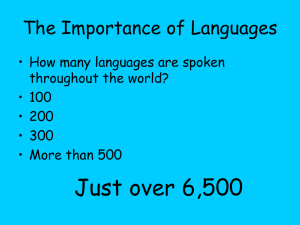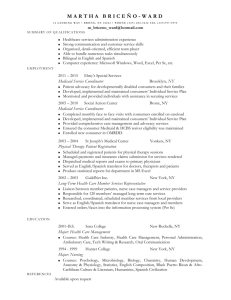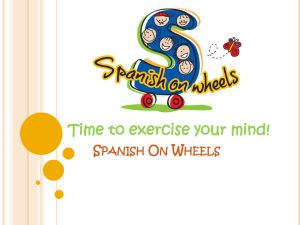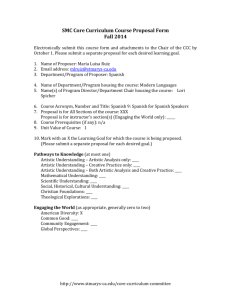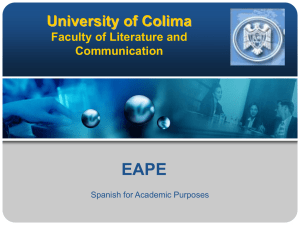Proposal
advertisement
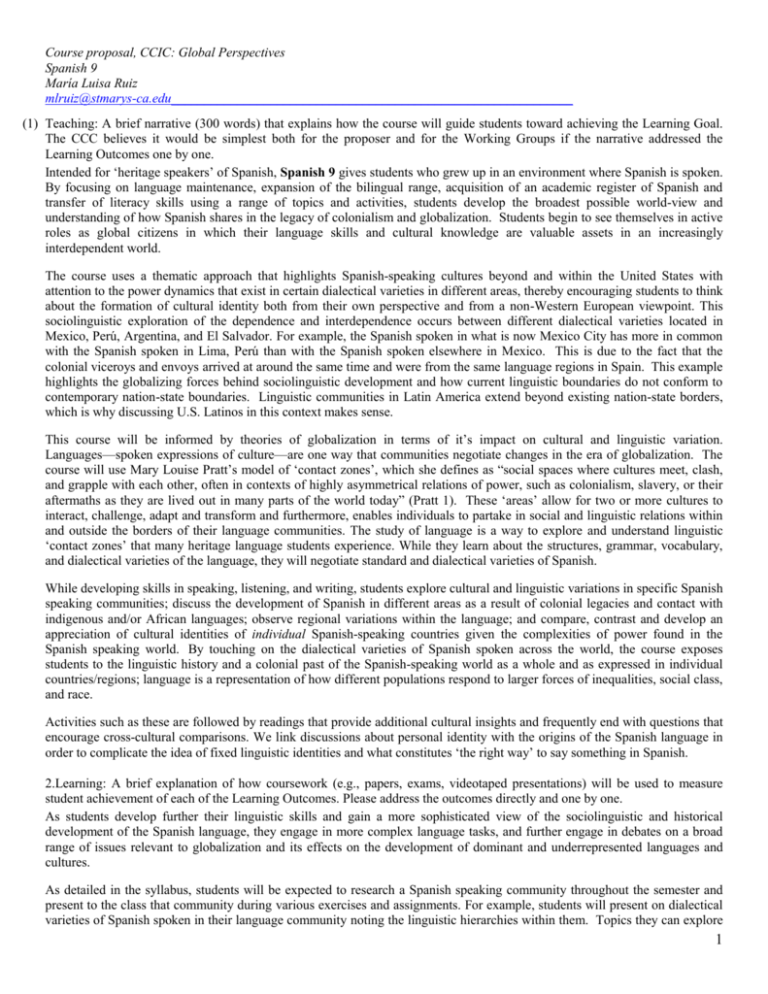
Course proposal, CCIC: Global Perspectives Spanish 9 María Luisa Ruiz mlruiz@stmarys-ca.edu_____________________________________________________________ (1) Teaching: A brief narrative (300 words) that explains how the course will guide students toward achieving the Learning Goal. The CCC believes it would be simplest both for the proposer and for the Working Groups if the narrative addressed the Learning Outcomes one by one. Intended for ‘heritage speakers’ of Spanish, Spanish 9 gives students who grew up in an environment where Spanish is spoken. By focusing on language maintenance, expansion of the bilingual range, acquisition of an academic register of Spanish and transfer of literacy skills using a range of topics and activities, students develop the broadest possible world-view and understanding of how Spanish shares in the legacy of colonialism and globalization. Students begin to see themselves in active roles as global citizens in which their language skills and cultural knowledge are valuable assets in an increasingly interdependent world. The course uses a thematic approach that highlights Spanish-speaking cultures beyond and within the United States with attention to the power dynamics that exist in certain dialectical varieties in different areas, thereby encouraging students to think about the formation of cultural identity both from their own perspective and from a non-Western European viewpoint. This sociolinguistic exploration of the dependence and interdependence occurs between different dialectical varieties located in Mexico, Perú, Argentina, and El Salvador. For example, the Spanish spoken in what is now Mexico City has more in common with the Spanish spoken in Lima, Perú than with the Spanish spoken elsewhere in Mexico. This is due to the fact that the colonial viceroys and envoys arrived at around the same time and were from the same language regions in Spain. This example highlights the globalizing forces behind sociolinguistic development and how current linguistic boundaries do not conform to contemporary nation-state boundaries. Linguistic communities in Latin America extend beyond existing nation-state borders, which is why discussing U.S. Latinos in this context makes sense. This course will be informed by theories of globalization in terms of it’s impact on cultural and linguistic variation. Languages—spoken expressions of culture—are one way that communities negotiate changes in the era of globalization. The course will use Mary Louise Pratt’s model of ‘contact zones’, which she defines as “social spaces where cultures meet, clash, and grapple with each other, often in contexts of highly asymmetrical relations of power, such as colonialism, slavery, or their aftermaths as they are lived out in many parts of the world today” (Pratt 1). These ‘areas’ allow for two or more cultures to interact, challenge, adapt and transform and furthermore, enables individuals to partake in social and linguistic relations within and outside the borders of their language communities. The study of language is a way to explore and understand linguistic ‘contact zones’ that many heritage language students experience. While they learn about the structures, grammar, vocabulary, and dialectical varieties of the language, they will negotiate standard and dialectical varieties of Spanish. While developing skills in speaking, listening, and writing, students explore cultural and linguistic variations in specific Spanish speaking communities; discuss the development of Spanish in different areas as a result of colonial legacies and contact with indigenous and/or African languages; observe regional variations within the language; and compare, contrast and develop an appreciation of cultural identities of individual Spanish-speaking countries given the complexities of power found in the Spanish speaking world. By touching on the dialectical varieties of Spanish spoken across the world, the course exposes students to the linguistic history and a colonial past of the Spanish-speaking world as a whole and as expressed in individual countries/regions; language is a representation of how different populations respond to larger forces of inequalities, social class, and race. Activities such as these are followed by readings that provide additional cultural insights and frequently end with questions that encourage cross-cultural comparisons. We link discussions about personal identity with the origins of the Spanish language in order to complicate the idea of fixed linguistic identities and what constitutes ‘the right way’ to say something in Spanish. 2.Learning: A brief explanation of how coursework (e.g., papers, exams, videotaped presentations) will be used to measure student achievement of each of the Learning Outcomes. Please address the outcomes directly and one by one. As students develop further their linguistic skills and gain a more sophisticated view of the sociolinguistic and historical development of the Spanish language, they engage in more complex language tasks, and further engage in debates on a broad range of issues relevant to globalization and its effects on the development of dominant and underrepresented languages and cultures. As detailed in the syllabus, students will be expected to research a Spanish speaking community throughout the semester and present to the class that community during various exercises and assignments. For example, students will present on dialectical varieties of Spanish spoken in their language community noting the linguistic hierarchies within them. Topics they can explore 1 Course proposal, CCIC: Global Perspectives Spanish 9 María Luisa Ruiz mlruiz@stmarys-ca.edu_____________________________________________________________ include: the history of Spanish in that community (i.e. who were the first Spanish speakers? Which dialect carried more prestige than others? Did the language ‘mix’ with indigenous languages?), unique characteristics of that language community (i.e. the use of ‘vos’? unique vocabulary?), well-known cultural ‘products’ produced by that language community (i.e. plays, music, movies?) and how globalization has influenced and/or changed them. Students can also explore language attitudes, the development of prestige varieties of that language community and also research the growing influence of English in Spanish and the language community’s reaction to its presence, highlighting the dependence and interdependence of how language is transformed by forces of globalization. In this way, each student obtains an understanding of the world from a specific viewpoint acknowledge the hierarchical nature of language development while also experiencing the similar but distinct viewpoints of their classmates. Additionally, adoption of a viewpoint different from their own and the development of its understanding is key to the students' ability to manage the language with adequate cultural competency given the expansion of the Spanish language in globalization. Projects that can be used for assessment include compositions, in-class presentations and/or debates, and a scripted ‘current events’ themed TV show/webcast students write and produce based on the topics described above. Because the course is primarily focused on developing student’s writing skills, students receive two grades—one for content and one for grammar/vocabulary-- for each composition. Students will also receive two grades for the multimedia projects based on content (based on the quality of the presentation, use of information, and understanding and application of different theoretical perspectives, and creativity) and grammar (use vocabulary/grammatical structures reviewed in class). These projects give students to opportunity to synthesize the technical aspects of language study with themes and topics that allow them to think critically about historical, social and linguistic processes influenced by colonization and processes of globalization. 2




